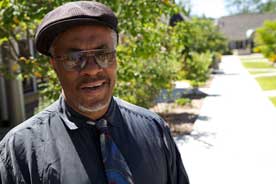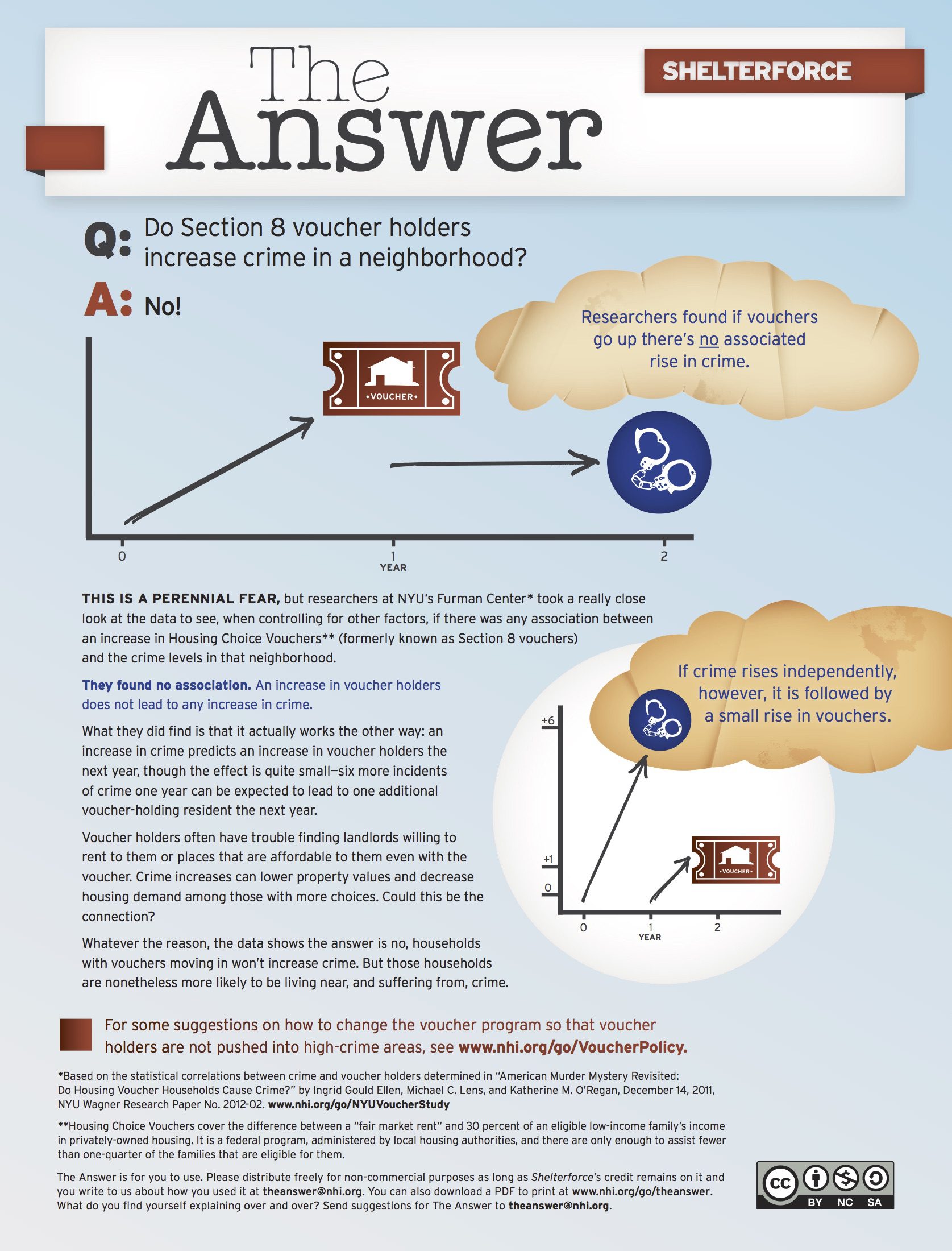
Willie Ledbetter, a veteran who is formerly homeless, has been through Soldier On’s program, and now works for Soldier On as the director of outreach and owns a unit in the Gordon H. Mansfield Veterans Community, Pittsfield, Mass. Photo courtesy of Soldier On
Jack Downing is president of Soldier On, a nonprofit veterans housing agency that provides 265 transitional beds for veterans in western Massachusetts, making it the largest provider of transitional housing for vets east of the Mississippi River. Downing began providing shelter beds for vets in 2001, but in 2004, as he listened to a soldier about to leave for the war in Iraq, he had an epiphany: Providing only transitional housing for veterans was something he, and the country, should be ashamed of.
“The hundreds of people in my care—and over 22 million vets—said they would die to protect our rights,” he explained. “Why is it OK for them to live in shelters, to be grateful for used clothing, and wait in line for food?”
Downing committed himself to pursue permanent housing for vets, but at the time few federal dollars were earmarked for it. Times have changed, however, and in 2011, Soldier On opened an award-winning 39-unit veterans housing cooperative, the Gordon H. Mansfield Veterans Community, in Pittsfield, Mass. The evolution at Soldier On is indicative of nationwide changes since 2010, when President Barack Obama announced a campaign to end veteran homelessness. As tens of thousands of U.S. troops in Iraq and Afghanistan streamed home, Congress appropriated hundreds of millions of dollars to ensure they were housed properly.
For the first time, permanent veterans housing became a focus. And federal funding often went through community groups already involved in the housing business, says Anthony Love, senior advisor to the Department of Veterans Affairs (VA) homeless programs and the National Center on Homelessness Among Veterans, because those groups were more “nimble” than federal agencies in finding places for vets “to live independently.”
“We had this audacious goal,” Love says, referring to the campaign to end veteran homelessness by 2015, “and we needed all hands on deck. The VA couldn’t provide the assistance alone.” This new approach to housing veterans has changed the landscape for community housing groups, and raised important questions, such as: How has housing vets changed? Is providing housing for veterans different than housing non-veterans? In what ways is it easier to house vets? In what ways is it more challenging?
Housing First: A Fundamental Change in Housing Veterans
Traditionally, the VA, which is primarily a health care provider, mixed its treatment of substance abuse and mental health problems with the task of providing veterans temporary housing. For example, vets often had to sign agreements to avoid drugs or alcohol in order to stay in government-provided transitional housing. But with the recent push to reduce veteran homelessness, the VA had to take a “hard look at best evidence-based practices,” Love says. It found that a housing-first model—common among community housing groups—led not only to getting homeless people into housing, but keeping them there for the long haul.
“It was no longer getting veterans better and then getting them housing,” Love says. “It was getting them housing and then working on those other issues.” To meet this goal, the VA closely collaborated with HUD, and far more money was pumped into the existing Veterans Affairs Supportive Housing program, known as HUD-VASH. HUD-VASH provides subsidized rental assistance through vouchers, providing permanent housing rather than transitional housing, and contributing to the economic viability of housing such as the Mansfield Veterans Community. The VA had its part to play in the program, providing case management for healthcare, as well as for mental health and substance use issues.
In a HUD-VASH pilot program targeting chronically homeless vets in 14 cities, 80 percent were still living in the housing a year later—an impressive figure. “Eliminating the chaos of homelessness,” Love points out, also reduced their health service needs, a good result for patient and provider.
More Vet Funding Makes It Easier to House Vets
Most community housing leaders I spoke with say it’s easier to find housing for vets because they have access to more government housing programs, including HUD-VASH vouchers and VA home loans, which were first provided to veterans returning from World War II (see here). Sheri Harris, chief operating officer for Bright Community Trust, oversees the Proud Pinellas vets homeownership program started in 2009 in Pinellas County, on the Gulf Coast of Florida. Most of the renovated homes are sold to vets and their families who have incomes that fall between 80 and 120 percent of the area’s median income. Because the program uses a community land trust model, where owners purchase the home, but only lease the land from the trust, the home is more affordable.
“The VA loans have made it possible,” says Harris of the program, which now has 80 homes in some stage of sale to veterans. The VA guarantees loans provided by banks and mortgage companies to eligible vets, making mortgages more accessible to them. They are even able to purchase homes with little or no money down, which can save them “upwards of $5,000,” Harris says.
In recent years, more funding has also come through lower-level government entities, nonprofits, and private foundations. In 2011, both Habitat for Humanity and The Home Depot were looking for ways to help veterans. Home Depot approached Habitat, says David Gilkeson, director of Veterans Build, the Habitat program that works to find housing solutions as well as employment and volunteer opportunities for vets. The connection led to the Repair Corps program, which helps repair, rehab, or build homes in partnership with vets. Since 2011, The Home Depot Foundation has donated $6.2 million to the Repair Corps, which has helped 280 vets.
The Cuyahoga Land Bank (CLB), whose region includes Cleveland, also added a veteran-specific program recently. Earlier this year CLB put up $100,000 to provide homeownership opportunities for vets. “We heard anecdotally of vets who were homeless and needed housing, and we thought we could be helpful,” says Dennis Roberts, director of programs and property management at CLB, which manages vacant property in the city. “We had a desire to help and reward people who have fought for our freedom.”
Cuyahoga County added $100,000 to the pool. Roberts says this is indicative of changing societal and political attitudes toward veterans: “People tend to look at veterans favorably today.” The funds allow CLB to give up to a 20 percent discount on housing prices to vets, something CLB can’t afford to offer otherwise. “If you buy a house that’s worth $100,000, and you pay $80,000, you immediately have $20,000 in equity,” Roberts explains. The land bank is also an example of the “nimble” community housing groups Love spoke of. If a veteran doesn’t have a strong enough credit rating to get a home mortgage, CLB will rent them a house for up to six months, often enough time to repair their credit. In one sale, the vet rehabbed some of the house on his own to save money; in another, CLB paid all the closing costs.
Challenges to Housing Vets
Many housing providers say that chronically homeless vets face the same challenges finding housing as do the chronically homeless population. “Bad credit, poor landlord references, and in some instances, criminal records, can be barriers,” says Brad Gordon, executive director of the Berkshire County Regional Housing Authority, which Soldier On has hired to teach its staff how to find housing for vets. Yet all acknowledge that vets often have their own issues that must be considered when working with them on housing.
“The major difference is, ‘What happened to that person in combat?’” says Linda Kot, program manager for Project Action for Vets, which provides housing support services and financial assistance to veterans and their families who are facing homelessness, through the Primavera Foundation, a NeighborWorks member in Tucson, Ariz. “They’ve experienced things the general population has not. And they bring a lot home with them.” As an example, Kot cites the statistic that over half of the vets returning from combat zones now have some sort of physical disability.
Many young vets who went into military service right after high school are also more prone to housing instability because they haven’t had much experience with negotiating civilian life. Length of service can make re-entry into civilian life bumpy, especially as they’ve been coming home to historically high unemployment rates. “We have some people coming back who have seen four, five, six tours of duty,” Kot says. They often lack basic life skills, such as how to rent an apartment, look for a job, or save money, Kot says. Notes Downing: “We bring them back into an unstructured life, no clothes, no food, nothing provided for you like it used to be, and we say, ‘Make it work.’”
Jamie Ebaugh, director of the Housing Resource Center at Detroit’s Southwest Solutions, which has provided low-income housing for 35 years, says that all staff who work with vets receive special training. “Sometimes vets can come across with an entitled attitude,” he says, which can cause community partners to be “taken aback.” Southwest Solutions staff are also asked to go through over a dozen online learning courses, which include training on post-traumatic stress disorder (PTSD), military culture, and re-entry issues, all intended to give them a well-rounded education on “who they’re dealing with and their complexities,” Ebaugh notes.
Finding Vets
One of the challenges of providing veterans with housing is finding those in need. At CLB, staff reached out to the local Veterans of Foreign Wars (VFW) to see if they knew of vets looking for reasonably priced homes. The VFW referred buyers to CLB, and they gave financial advice about purchasing a home and also helped CLB home buyers find furniture. “I get the sense that veterans work in a tight network,” says CLB’s Roberts. “They like to work with other vets. Once you [have] work[ed] with them, your marketing is likely to be more effective.”
Habitat’s Veterans Build has also encountered this. “A lot of our affiliates have a challenge identifying vets to participate in the program,” Gilkeson says. “The vet community is generally not one that asks for help.” To find vets, Habitat spreads its net wide, working with a number of veteran-related groups, including Team Rubicon, Easter Seals Dixon Center, Student Veterans of America, Volunteers of America, and Veterans Plus.
“We’re trying to create a network of veterans so we can serve and support the needs of veterans with affordable housing solutions,” Gilkeson says. “Most of these relationships are built on the idea that one plus one equals three.” Habitat has also worked to build a relationship with the VA, which refers vets who need critical home repairs to the program.
Habitat doesn’t treat vets as broken men or women, but as people devoted to service who want to continue serving once they’ve left the military. “We’re not a hand-out, we’re a hand up,” Gilkeson says of the Veterans Build program. “You’re buying your home. We truly believe that you have to do the work, put in the sweat equity. It’s more valuable if you work for it.” A 2008 study by Civic Enterprises found that 92 percent of vets felt that serving their community was important, but 69 percent had not volunteered because they hadn’t been asked.
Habitat works with vets at lower income levels to make sure they’re not spending more than 30 percent of their income on mortgage payments. This is in light of the 1.5 million veteran households that paid more than 50 percent of their income on housing, according to a study by the National Low Income Housing Coalition. A disproportionate number of these cost burdened households were headed by people of color, women, and people with disabilities.
Supporting Vets in Integrated Housing
The Supportive Services for Veteran Families program (SSVF), which was introduced by the VA in 2011, provides government financial resources to community groups that work to keep veterans in their homes. SSVF provides money to community agencies to give assistance to vets for health care, transportation, legal services, and childcare. The program also provides temporary funds to pay for expenses such as rent and utilities to tide a vet through difficult financial patches.
“The VA looked to the community because we were already experts at the model, and can move more quickly,” Kot explained. “They saw us as the experts, and said, ‘Go for it.’”
Much of the veterans housing supported by SSVF is integrated in the community. Using SSVF funds, Soldier On has subcontracted the Berkshire County Regional Housing Authority to train its staff in how to find integrated housing for vets. “It’s about vets having choices,” says Brad Gordon, executive director of the Berkshire County Regional Housing Authority. “Some vets want to live with vets. Some want to live with non-vets. They shouldn’t be more restricted in their selection process than the general population.”
In 2010, Southwest Housing Solutions raised $23 million to build Piquette Square for Veterans in Detroit’s New Center area, providing 150 affordable and furnished permanent apartments for homeless veterans. The apartments filled up in two and a half months. That “didn’t surprise us at all,” says Ebaugh.
Using SSVF funding, Piquette Square has staff visit renters in their apartments, Ebaugh says. “You see a lot of what’s going on with someone when you visit them where they live,” he says. “While we’re addressing their mental health and their physical health, the main focus is to keep people in their homes.” Staff try to pass on basic life skills that are often lost to previously/chronically homeless people, such as how to pay rent, who to contact if something breaks in their apartment, or who to call in an emergency. ”It’s stuff we take for granted,” Ebaugh says, “but for people who were on the streets, we’re orienting them to services and the neighborhoods they’re in.”
Reintegrating them into the community is key. “On the streets, they spend a lot of time surviving, getting food and shelter,” Ebaugh says. “When you provide that, the question is, ‘Now what?’ They want more than sitting around all day. We try to help them recreate a social structure, getting them employed, or education, or volunteer opportunities, or sometimes connecting them back to family.” The VA even for a time provided a staffer at Piquette Square, an unusual move.
Such outreach is a break from the traditional VA medical model, in which veterans are expected to visit a hospital for all their services. For veterans in Soldier On housing, Downing hires staff through SSVF to meet with vets in their homes. “We deliver all the services where you live,” Downing says. “If we can’t deliver the services to you, we deliver you to the services.” This is key, he says, because only 17 percent of vets have a driver’s license, a big reason they often don’t seek out services that were once only available at VA hospitals. At Soldier On housing, vets are provided a toll-free number to call when they have a problem. Staff, whose “cars are their offices,” Downing says, visit them within two days.
Downing dreams that one day nearly all the tax dollars spent on veterans housing will be devoted to permanent rather than temporary housing. “In the next 10 years,” he says, “if we build 500,000 to a million permanent places for vets, then we will have secured vets from ever being homeless again.”




Comments